I’m a petite woman who is barely above 5 feet tall and my torso length is just 14 inches. This makes it incredibly difficult for me to find backpacks which fit me. It’s even harder to find UL or large-capacity backpacks for short women.
After a lot of research and talking to other petite female backpackers, I’ve managed to compile a list of hiking packs for petite women. All of these have torso lengths of 15 inches or less.
Comparison Table
| Pack | Capacity* | Torso Length | Waist | Buy At |
|---|---|---|---|---|
| Osprey Eja Pro 55 | 52 | 13-17 | 26-45 | Amazon, REI |
| Osprey Eja 58 | 55 | 13.5-17 | 26-50 | Amazon, REI |
| Osprey Lumina 60 | 54 | 15-17 | 24-45 | Amazon |
| Osprey Ariel 65 | 62 | 13.5-17 | 26-45 | Amazon, REI |
| Osprey Ariel Pro 65 | 62 | 14-17 | 24-28 | Amazon, REI |
| Osprey Renn 65 | 65 | 14-19 | 25-50 | Amazon, REI |
| Osprey Aura | 62 | 13.5-17 | 26-50 | Amazon, REI |
| Osprey Ariel Plus 70 | 70 | 14-17 | 26-50 | Amazon, REI |
| Gregory Octal 45 | 42 | 14-16 | 26-45 | Amazon |
| Gregory Wander 50 Kids | 50 | 13-18 | 22-48 | Amazon, REI, Campsaver |
| Gregory Facet 55 | 52 | 14-16 | 26-45 | Amazon, REI |
| Gregory Maven 55 | 52 | 14-18 | 26-45 | Amazon, REI |
| Gregory Kalmia 60 | 55 | 14-17 | 22-46 | Amazon, REI |
| Gregory Maven 65 | 65 | 14-17 | 24-26 | Amazon, REI |
| Gregory Jade 63 | 63 | 14-17 | 24-26 | Amazon, REI |
| Gregory Deva 70 | 56 | 14-16 | 26-46 | Amazon, REI |
| Gregory Wander 70 Kids | 70 | 13-18 | 22-48 | Amazon, REI, Campsaver |
| Gossamer Gear Mariposa | 60 | 13.5 | 28-45 | Garage Grown Gear |
| Mystery Ranch Coulee | 40 | 13-18 | 26-32 | Amazon, Campsaver |
| Mystery Ranch Bridger | 55 | 13-18 | 26-32 | Campsaver |
| Mystery Ranch Bridger | 65 | 13-18 | 26-32 | Campsaver |
| Mystery Ranch Glacier | 70 | 13-18 | 26-32 | REI, Campsaver |
Quick Picks:
- Best Overall: Gregory Octal 45 – it is comfortable and a good balance between sturdiness and weight.
- Best Ultralight Pack: Osprey Lumina 60
- Best Large Pack:
*Important: The XS size of backpacks usually have a smaller capacity than the one listed in their name. For example, the Osprey Lumina 60 only has a capacity of 54L in the XS size.
My Top Picks
I’m not going to go over every single short/XS women’s backpacking pack, but here are some of my top picks based on the features they have.
Osprey Aura 65 AG
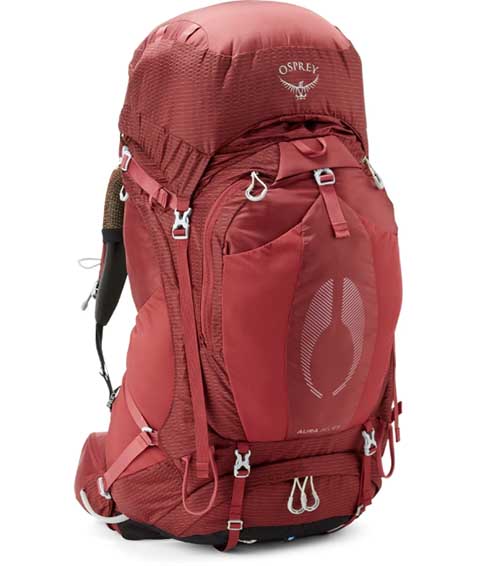
There are four versions of this women’s pack: 50 AG LT, 50 AG, 65 AG LT and 65 AG. The “LT” versions are lighter weight. But, in order to cut back on the weight, these are missing some features that the standard AG models have. All come in XS/S sizes with a torso length adjustable down to 13.5 inches.
The thing I really like about the Aura packs is that there are multiple side compression straps. These allow you to cinch up your pack so it sits close to your body. The fit is better and you won’t have as much wobbling around like with some packs.
Best For: All around great pack with tons of features
- Capacity: 62L
- Weight: 4 lbs. 7 oz.
- Torso: 13.5-17 inches
- Waist: 26-50 inches
- 8 exterior pockets
- Ventilated back mesh panel
- Aluminum frame
- Main fabric: 210-denier recycled nylon; 500-denier recycled nylon
- Lifetime warranty
- Get it here at Amazon or at REI
Osprey Lumina 60 XS
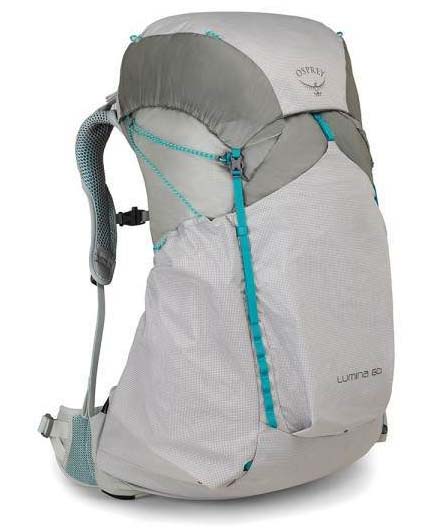
Best For: Ultralight backpacking
- Capacity: 54L
- Weight: 1lb 12.8oz
- Torso: 15-17 inches
- Waist: 24-45 inches
- Max Load: 25lbs
- Ventilated back mesh panel
- 6065 aluminum hoop stay
- Adjustable sternum strap
- Main fabric: 30D Cordura® Silnylon Ripstop
- Lifetime warranty
- Get it here
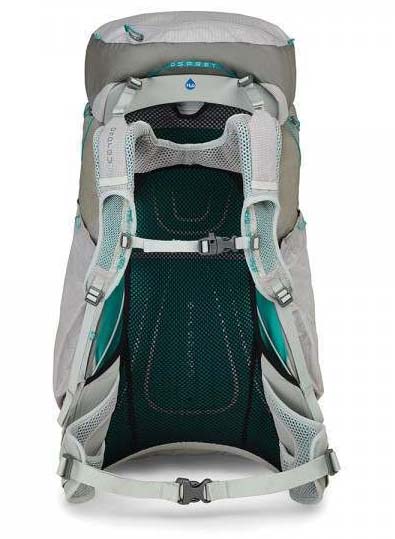 At under 2lbs, the Osprey Lumina is one of the lightest weight packs specifically for women available. As I talk about in this post about ultralight backpacking tips, you might not actually want an ultralight backpack. They aren’t designed to carry a lot of gear. The lack of frame means weight isn’t distributed as well down to your hips.
At under 2lbs, the Osprey Lumina is one of the lightest weight packs specifically for women available. As I talk about in this post about ultralight backpacking tips, you might not actually want an ultralight backpack. They aren’t designed to carry a lot of gear. The lack of frame means weight isn’t distributed as well down to your hips.
As expected with UL backpacks, the pack is missing a lot of standard features. It doesn’t have much padding, so comfort isn’t the best. However, there are four pockets including a zippered lid where you can stash items and compression straps for securing items to the pack. It’s hydration pack compatible so you don’t have to worry about the backpack not having water bottle pockets.
The shoulder straps are J-shaped, so this might not be the best pack if you have larger breasts. The mesh back panel does give your bootie a bit of room though. The aluminum stay can also be bent to fit your contour, which is a big plus for curvy women.
Gregory Deva 70 XS
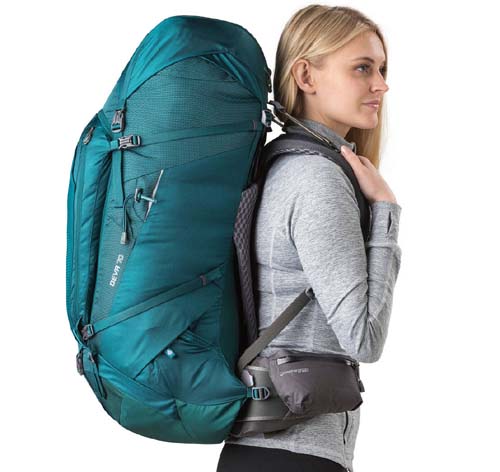
Best For: Comfortably carrying heavy loads, especially on long treks
- Capacity: 56L
- Weight: 4lbs 7.7oz
- Torso: 14-16 inches
- Waist: 26-46 inches
- Max Load: up to 50lbs
- Response A3 suspension system
- Adjustable shoulder, hip and sternum strap
- S-shaped shoulder straps
- 9 exterior pockets
- Removable daypack
- Aluminum frame
- Rain cover included
- Main fabric: 210-denier Honeycomb CryptoRip nylon
- Get it or here at Amazon
Gregory is one of the backpack manufacturers which actually makes women-specific packs. Yes, lots of brands say their packs are for women, but they are actually just shorter versions of the men’s packs.
Here are some of the women-specific features on Gregory packs:
- S-shaped shoulder straps to accommodate bust
- Shorter torso
- Hip belt angled to fit a woman’s steeper hips
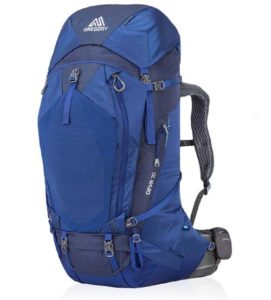 While Gregory makes a lot of women’s packs, this is my favorite. At about 4 1/2 lbs. it is a bit on the heavy side, but the suspension system makes it feel like you are carrying less weight than you really are.
While Gregory makes a lot of women’s packs, this is my favorite. At about 4 1/2 lbs. it is a bit on the heavy side, but the suspension system makes it feel like you are carrying less weight than you really are.
The system, called Response A3 (Automatic Angle Adjust), causes the shoulder straps and hip belt to pivot. As you move, the pack will adjust to your torso angle. Everything about the suspension system is adjustable: shoulder harness, lumbar area, and hip belt. You can get the perfect fit regardless of your body type.
As for organization, the Deva has 9 exterior pockets. Three of these are in the lid, three on the front of the pack, two in the hip belt, and one on each side of the pack. You can access gear from a top pocket or a large U-shaped front panel pocket.
The water bottle pocket is a bit weird, especially since it isn’t symmetrical and you thus must carry your bottle on one side (not ideal for left-handed people like me). But the slant is actually pretty cool since it makes the bottle more accessible.
As 70L, the Deva is large enough for all of your gear, including a bear canister. The max carry load is 50lbs, so enough for even long thru-hikes.
Get it or here at Amazon
Gregory Octal 45 XS
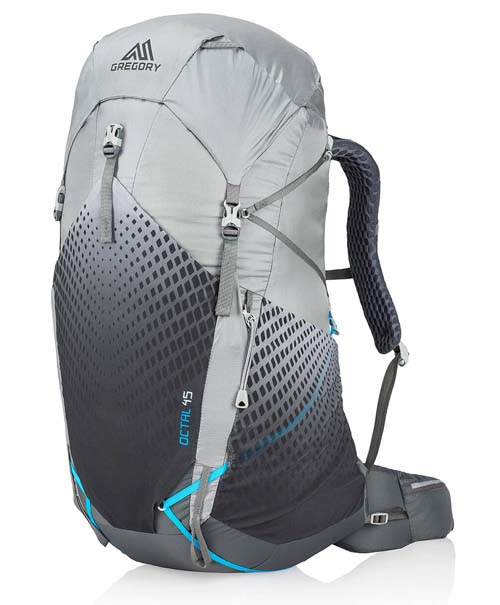
Best For: Affordable, lightweight mid-sized women’s pack
- Capacity: 42L
- Weight: 2.3lbs
- Torso: 14-16 inches
- Waist: 26-45 inches
- Max Load: 30lbs
- S-shaped shoulder straps
- 5 exterior pockets
- Ventilated mesh back panel
- Lumbar pad
- Aluminum perimeter wire frame stay
- Rain cover included
- Main fabric: 100-denier/210-denier HD tenacity nylon (body); 135-denier HD polyester (lining)
- Get it here at Amazon
At 2.3lbs, the Gregory Octal 45 almost meets the ultralight pack definition. For its weight class, the Octal 45 still has a lot of features you’d expect in a standard hiking pack. There is lots of storage, cushioning, and a sturdy frame. This makes it a good choice for backpackers who want to go UL but aren’t ready to sacrifice comfort.
Let’s start with the size of the Octal 45 pack. It’s fairly small at just 42L for the XS size. However, there are three spacious, stretchy pockets on the outside of the pack. The side pockets are designed in a way so you can put a water bottle in horizontally for easy access. Or you can shove sandals, clothes, or snacks there. The center exterior pocket can fit an entire rain jacket, so you can really extend the capacity of the pack so long as you stay under the 30lb max weight load.
In addition to the three exterior pockets, there are also two hip belt pockets. These are more spacious than the hip pockets you’d find in other women’s packs. There are also multiple places to attach gear like sunglasses, trekking poles, or communication devices.
As for comfort, this is one of the most comfortable hiking backpacks, especially for curvy women. The S-shaped shoulder straps don’t have a very pronounced curve so it might not be great if you have very large breasts. But there is a lot of padding on the hip belt plus extra lumbar support, so the pack works well for women with a bigger booty.
Annoying things about the pack? The main compartment can only be accessed through the top. The torso isn’t adjustable. The suspension system isn’t as good as many other Gregory packs.
Get it here at Amazon
Osprey Renn 65
Best For: Short women who want an affordable large-capacity pack, even if it means sacrificing some features
- Capacity: 65L
- Weight: 3lbs 7oz
- Torso: Adjustable 14-19 inches
- Waist: 25-50 inches
- S-shaped shoulder straps
- 5 pockets
- Ventilated mesh back panel
- LightWire peripheral hoop frame
- Rain cover included
- Main fabric: 600-denier polyester
- Get it or here at Amazon
One of the problems with large-capacity women’s backpacks is they tend to be very tall. For us short women, that means the pack ends up extending above our heads. This puts the center of gravity up higher and throws us off balance. The Osprey Renn is one of the few packs which doesn’t do this.
Compared to other packs this size, the Renn is actually pretty wide. The width means the center of gravity ends up being much lower, so you won’t feel like the pack is pulling you backwards. If you are a petite woman and regularly haul very large loads, the Renn is a good solution.
As for comfort, the Renn does a decent job. The suspended mesh back provides lumbar support and keeps you from getting drenched in sweat. The torso can be adjusted to pre-set lengths, which means you can try out a few to see which is most comfortable. Unfortunately, the hip belt padding might not hit the right spot if you have larger hips. The shoulder straps might also end up squeezing your bust if you have a very large chest.
Considering this is a large pack meant to carry lots of heavy gear, I was surprised at how few organizational features the Renn 65 has. Yes, there are lots of pockets including hip belt pockets, a lid pocket, and two side pockets (which also have horizontal access). However, there isn’t a back stash pocket. Nor are there many loops or attachment points for gear. Osprey likely left these off so they could keep the weight and price of the pack down. For some women, these tradeoffs will be worth it. Others should consider a more feature-rich pack like the Osprey Lumina or Gregory Deva.
Get it or here at Amazon
Tips for Buying a Hiking Pack for Petite Women
Here are some backpack buying tips specifically for short, petite women.
Keep Center of Balance Low
Women’s backpacks are usually narrower than men’s backpacks to account for our slimmer shoulders. This makes the packs more comfortable for us. However, it also means women’s packs can end up tall and skinny. For short women, the top of the pack might end up high above the head, causing it to be top-heavy and hard to balance.
Ideally you keep your gear minimal so you don’t have to get a huge pack that goes above your head. If you are unable to do this, then it might be better to choose a wider pack, like the . Or, make sure your pack has lots of loops and straps so you can attach gear to the outside instead of having to extend the lid.
Don’t Rely On Adjustable Torso Length Alone
Adjustable torso length is a great feature to have. It allows to you get a near-perfect length. However, don’t rely on adjustable torso too much – especially if the torso can be adjusted by many inches. Here’s why.
Let’s say a pack has an adjustable torso length of 14-22 inches. When you put the torso at the shortest setting, the shoulder straps are further down on the pack. This means the top of the pack ends up very high, possibly over your head. It’s better to find a pack with a torso length which matches yours or can be adjusted by a small amount to perfect the fit.
Weigh Gear before Buying a Pack
A backpacker shouldn’t carry more than 20% of their body weight. For petite women, this can be a very hard goal. I’m only 110lbs, so I’d need to get my pack weight – including water and food – to 22lbs or under.
Before you buy a backpacking pack, I suggest you lay out all of your gear and weight it. If it is totaling more than 20% of your bodyweight, then consider whether there is any gear you don’t need or whether it makes sense to buy a lighter version of certain gear. Once you’ve done this, you’ll be better able to choose a pack suitable to what you really need to carry.
Also read: How to Go Ultralight without Spending Fortune
Lightweight Packs Aren’t Always the Best Choice
In an effort to get your base weight down, you might be tempted to get an ultralight backpack. However, this is often a bad idea. UL backpacks aren’t as comfortable nor are they as good at transferring load to your hips. As a petite woman, this load transfer is very important! It’s better to have a pack which weighs 1lb more but makes your overall load feel 10lbs lighter.
Look At Return Policies
Buying a hiking pack is all about getting the fit right. Even if you go into a store, you won’t be able to really feel how comfortable a pack is until you’ve tried it weighted down. Here’s what you need to do:
- Check the return policy before you buy the pack. REI generally has good return policies on unused gear. Amazon return policies can vary depending on the seller.
- Once the pack arrives at home, load it with 20+lbs of weight.
- Take a walk around your neighborhood with the pack on.
- Does the pack still feel comfortable? If not, return the pack within the return period!
Consider the Youth Department
A lot of youth backpacking gear is just as good as the adult’s gear, but it usually costs a fraction of the price. Since I’m so small, a lot of my hiking boots, rain pants, and other gear comes from the youth boys section.
This method doesn’t always work well with backpacks. Youth backpacks don’t have S-shaped shoulder straps to accommodate breasts nor do they have hip belts designed for a woman’s curvier figure. However, if you are a slim, less-curvy petite woman, you might find lots of youth packs which fit you well.
Are you a small women? What hiking pack do you use? Let us know in the comments section below.


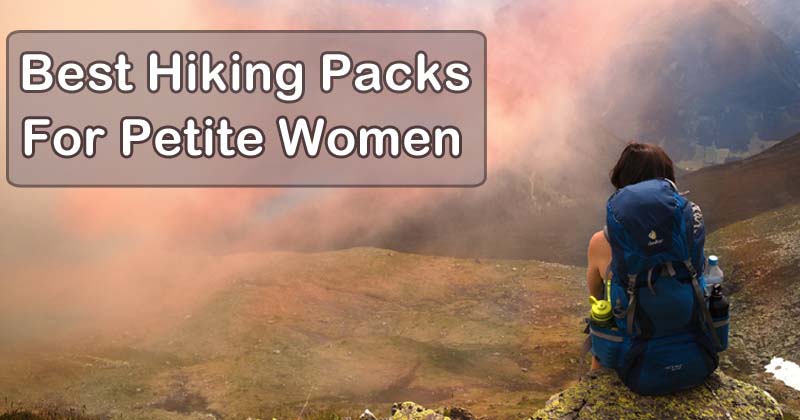
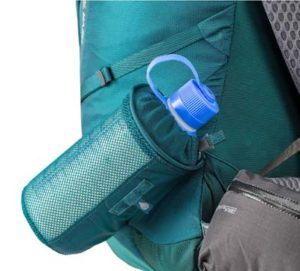
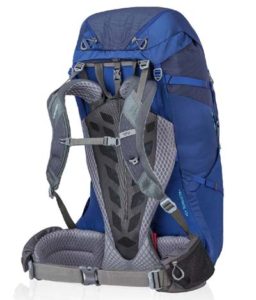
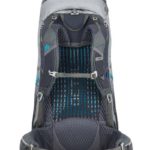
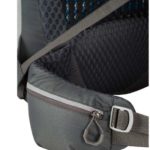
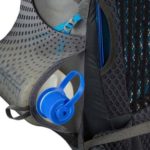
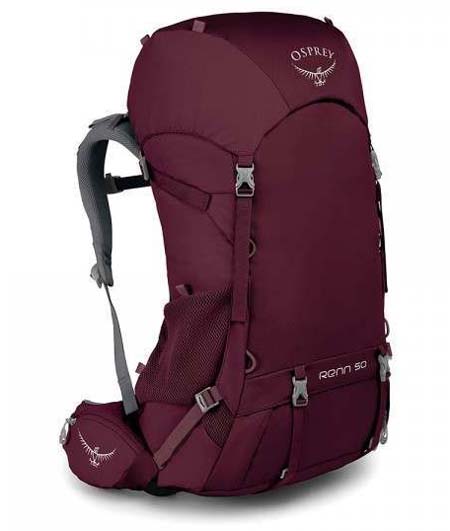
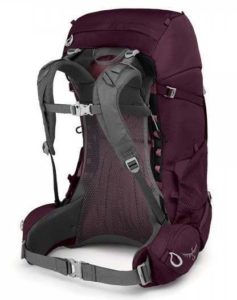
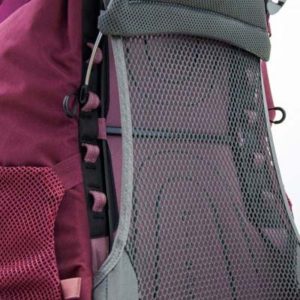

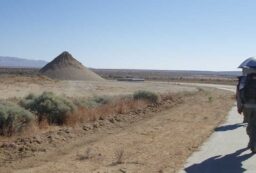
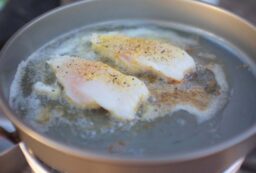







18 Comments
Kathleen
October 2, 2020 at 4:25 pmThanks for this post. Always searching for the ‘perfect’ fit
GabbyGirl
January 11, 2021 at 6:08 pmThanks for your post! I’m at 5’2”, 140lbs so am always looking for petite sizing. I appreciated the tip on the low center of gravity and hasn’t thought about looking for a pack that accommodates/ can fix for that. I just presumed that was a given.
It’s hard to find a good fit in the outdoor world. Is it me or does it seem like everything is for the Amazonians at 5’9” and above and weigh next to nothing?
Diane
January 12, 2021 at 11:06 amI’m glad you found it useful 😀 And, yeah, everything does seem to be made for Amazonians! At least brands are actually starting to make gear for women though. Hopefully the next step will be to make it for petite women!
Freya
May 2, 2021 at 7:27 amWow, I wish I had this review to refer to a few years ago when I bought my Osprey Aura AG 65! I’m 5’ tall, about 120 lbs and bought the XS. The fit is amazing and very customizable. I’m able to get almost all of the load sitting at or near the bottom/middle of the pack so that the center of gravity is nice and low. In fact, with packing everything at the bottom I was able to completely remove the lid. So, overall everything is packed low like a short, wide rectangle. My head is able to move freely and I no longer have that feeling of being pulled backwards like so many other packs. It’s very comfortable and very breathable. HOWEVER…this pack is quite heavy at 4.25 lbs. Because you should only carry 20% of your bodyweight, that means a huge chunk goes to my backpack alone. I should be carrying about 24 lbs but even with some new, lighter gear, I’m still at about 30 lbs which is 25% of my bodyweight! So, this article has been super helpful in potentially making the switch to a different, lighter pack. Thank you!
Diane
May 10, 2021 at 2:02 pmI’m glad you found it helpful. 🙂 It does seem like all gear articles are aimed at 6 foot tall guys! I also prefer a lighter pack starting out. But just be careful about getting too swayed by the ultralight-hype. A heavier pack which fits well and has a nice hip belt will feel lighter, even if it weighs more.
Freya
May 11, 2021 at 7:21 pmI’m 5′ tall and after many uncomfortable trips it occurred to me that I had to pack my bag totally different than all the “experts” recommend, because it just doesn’t work for a super short person like myself. The most important thing I’ve learned to really get that center of gravity low (and therefore avoid that feeling like I’m being pulled backwards) is to load absolutely everything I possibly can into the bottom of my pack. Especially anything that isn’t lightweight!
First, I realized I couldn’t keep anything in the lid. That was definitely contributing to the “being pulled backwards” feeling. All those little items like snacks/headlamp/sunscreen/maps/phone/etc. don’t seem like much separately, but when you put them all together, it’s enough weight at the top to contribute to that uncomfortable feeling. Plus, the lid of a pack is almost always above your head…and, us short folks need our bag to be low and wide! So, I ditched the lid completely. (This is obviously not something you can do with a rolltop pack.)
My suggestions here all depend on the pack you are using and/or considering, but I think this packing method will be helpful overall. I basically stuff and cram all the heavy things at the bottom and work my way up. (If you don’t have access to the bottom of the pack from the outside via an access zipper, then this method will require some tweaking, but the principle remains the same = get everything heavy as low as possible!)
– First I start with my full water bladder and instead of putting it inside the built-in sleeve that comes with most packs, I don’t use that sleeve and instead slide the bladder all the way down to the bottom of the bag (it’s still upright, but instead of being in the middle of my back, it’s now as low down as possible).
– Next, using the bottom access, I take the tent and roll each piece (tent & fly) into 2 short cylinders and put elastic bands tightly around them, then I squeeze each one in on either side of the water bladder as low in the pack as possible.
– Again, using the bottom access, my food/cooking bag goes in the middle as low as possible in front of the water bladder.
– Then (still working from the bottom) the ground sheet gets folded very small and tight, I place an elastic around it, and stuff it in front of the rolled tent fly into the corner as much as possible. I then stuff my mini toiletry bag really far into the corner in front of the rolled tent.
– Then, I close the bottom zipper and start placing my other items inside on top of that whole stuffed layer going lighter as you work your way up.
– I place my rolled sleeping pad (in it’s stuff sack) vertically on top of the tent fly, I place my stuff sack with base layers/socks/underwear on top of the tent body (making sure it’s in a more upright position). In the middle of those two things goes any heavier items like water filtration system/spare clothes/pillow/etc.
– Then I stuff my puffy jacket in and around any holes.
– My sleeping bag goes on top in it’s stuff sack.
– Then I tighten and cinch down the top.
– Once all that is done, I open the bottom access zipper again and push everything upwards as much as possible to get a bit of space for all the things I would normally keep in the lid: snacks/headlamp/sunscreen/maps/phone/gloves/toque/etc. and stuff these wherever I can. – The very last thing that goes in the bottom is my folded rain jacket (for easy access) and my maps/trail info in a large ziploc.
– I don’t put anything heavy on the outside of the pack, especially in the center. I only use the outside side mesh pockets for my camp sandals, and the center outside mesh pocket for my plastic food plate/utensils/toilet paper. (These are still placed as low as possible in the mesh.)
– My pack comes with roomy hip belt pockets, so I put a lot of snacks in one of these pockets, and my camera goes in the other.
Now, you may be wondering how the heck do I refill my water bladder since it’s so low down in the pack? Well, even though everything was packed super tight inside the bag, once your water gets low and/or empty, you now have a bit of space in there, so I’m able to reach down and pull the bladder upwards towards the top. (I just don’t take it out completely to refill it.) Once it’s full again, I just push it back down to the bottom.
This system has been an absolute game changer for my backpacking trips, so I hope it helps someone else feel a bit more comfortable out on the trail!
Diane
May 12, 2021 at 11:03 amThis is incredibly helpful. I also have a tendency to overpack my lid and get top heavy, but I really like the convenience of having certain items there. Based on what you wrote, I might try to put more items in my sleeping bag compartment so they are still accessible but the weight is lower. Thanks 🙂
Paige
May 17, 2021 at 12:35 amI am 4’10” and found your article incredibly helpful. I made the mistake of going UL and I completely regret it. I can’t return the ULA backpack, but lesson learned. It is very uncomfortable – especially in the shoulders – it’s actually painful.
I have an osprey I’ll go back to for day hikes and I’ll look at the others you have highlighted for backpacking.
Diane
May 17, 2021 at 8:39 amThat sucks you can’t return the backpack, but you can probably at least sell it.
Veronica
July 15, 2021 at 3:46 amHello petite fellow! I’m 4’9 and weigh 92-94 pounds and it’s been quite difficult. The octal 45L is uncomfortable on the lumbar as it bulges and touches my spine and i have a space on the shoulders. I also feel it pulls me back. Gregory Jade not great fit either. Tried Osprey Kyte, Sirrus, and Lumina. Even tried REI Tarn 40 for kids and uncomfortable. Any suggestions?
Shelby
January 19, 2022 at 3:04 pmLove that I’m not the only one struggling with this. I’m 5’1″ and have been shopping in the kids section my whole life for gear and such because for some reason the world defines “short” as 5’4″-5’6″ which leaves the rest of us out. I recently got upset with a company that boasts about body inclusivity for their clothes but then doesn’t offer any sort of short option for their leggings and I had about 5 inches bunched up around my ankles. I guess body inclusivity doesn’t include us short people.
Anyway, I use the REI Ruckpack 65L (I think they discontinued it) and I got super lucky with the fit of this thing. It was before I knew a ton about torso length, but it’s quite comfortable and it looks more like a turtle shell on my back instead of being so tall and skinny and above my head. For me, this helps me feel like everything is actually on my back instead of floating somewhere above me. It’s also great to use as a checked bag. If you can find one somewhere, I’d recommend giving it a shot. It’s been great for me the last few years.
Diane
January 20, 2022 at 6:04 pmThat’s awesome that you found a pack which fits well. I hate that REI discontinues a lot of stuff so quickly. Right when you find something awesome, it is gone. :/
Shreedevi Chavda
July 6, 2022 at 6:14 pmHave you any suggestions for a small ,say 10l size, daypack with waist strap, pl? I’m 75yrs old with a bit of a shoulder issue. But i walk long distances n need to carry just the essentials like sandwich m water bottle.
Diane
July 7, 2022 at 9:52 amIt sounds like you need a proper hip belt. Unfortunatley, most small packs only have tiny waist straps and not proper hip belts. Osprey does make a few though. Their packs are pricy but fantastic. Their 9L Tempest pack might work for you (https://amzn.to/3P8uxsj). Their Talon 11 is also good option (https://bit.ly/3ImS1rz) but it’s a men’s pack — that means the straps don’t curve and might bother you if you have a larger bust. If you don’t need a proper hip belt, then you can find lots of cheaper packs with thin waist straps.
Theresa
August 11, 2022 at 7:32 amThank you for this information! I am also small with torso length 15”. Someone recommended the Zpacks Arc Haul 60 Women- have you had to opportunity to test this?
Diane
August 14, 2022 at 6:33 pmI haven’t tried that pack but I know lots of people love Zpacks. They’ve got a cultlike following with ultralighters 🙂 Their packs are expensive — so make sure you really test it out right when you get it. The return period is 30 days and you’ll have to pay return shipping!
Vick
January 29, 2024 at 11:19 pmSo far the best, most comfortable, “video/photo” backpack with adjustable torso length & hip belt for petite individuals is a Shimoda v2 25L Women collection. They’re geared towards action/adv, but still far from a real hiking backpack.
Which one on your list has quick access to insert a camera cube storage unit? (Preferably towards the bottom half)
Diane
January 30, 2024 at 1:57 pmThat Shimoda pack does look nice. 🙂 Unfortunately, none of these packs have that feature. If your camera cube is on the smaller side, you might want to consider carrying it on your front, attached to the pack straps. I personally hate having something attached to my front (especially because I’ve got to detach it each time I put my pack down to pee, which I do frequently :D). But some people don’t mind this.